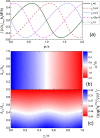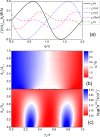Identifying the chiral d-wave superconductivity by Josephson φ0-states
- PMID: 28266582
- PMCID: PMC5339699
- DOI: 10.1038/srep43899
Identifying the chiral d-wave superconductivity by Josephson φ0-states
Abstract
We propose the Josephson junctions linked by a normal metal between a d + id superconductor and another d + id superconductor, a d-wave superconductor, or a s-wave superconductor for identifying the chiral d + id superconductivity. The time-reversal breaking in the chiral d-wave superconducting state is shown to result in a Josephson φ0-junction state where the current-phase relation is shifted by a phase φ0 from the sinusoidal relation, other than 0 and π. The ground-state phase difference φ0 and the critical current can be used to definitely confirm and read the information about the d + id superconductivity. A smooth evolution from conventional 0-π transitions to tunable φ0-states can be observed by changing the relative magnitude of two types of d-wave components in the d + id pairing. On the other hand, the Josephson junction involving the d + id superconductor is also the simplest model to realize a φ0- junction, which is useful in superconducting electronics and superconducting quantum computation.
Conflict of interest statement
The authors declare no competing financial interests.
Figures




Similar articles
-
Josephson effect in junctions of conventional and topological superconductors.Beilstein J Nanotechnol. 2018 Jun 6;9:1659-1676. doi: 10.3762/bjnano.9.158. eCollection 2018. Beilstein J Nanotechnol. 2018. PMID: 29977700 Free PMC article.
-
Direct coupling between magnetism and superconducting current in the Josephson phi0 junction.Phys Rev Lett. 2008 Sep 5;101(10):107005. doi: 10.1103/PhysRevLett.101.107005. Epub 2008 Sep 5. Phys Rev Lett. 2008. PMID: 18851248
-
0-pi Transitions in a superconductor/chiral ferromagnet/superconductor junction induced by a homogeneous cycloidal spiral.Phys Rev Lett. 2008 Feb 22;100(7):077003. doi: 10.1103/PhysRevLett.100.077003. Epub 2008 Feb 21. Phys Rev Lett. 2008. PMID: 18352588
-
Demonstration of the Nonlocal Josephson Effect in Andreev Molecules.Nano Lett. 2023 Aug 23;23(16):7532-7538. doi: 10.1021/acs.nanolett.3c02066. Epub 2023 Aug 8. Nano Lett. 2023. PMID: 37552598 Free PMC article.
-
Beyond Moore's technologies: operation principles of a superconductor alternative.Beilstein J Nanotechnol. 2017 Dec 14;8:2689-2710. doi: 10.3762/bjnano.8.269. eCollection 2017. Beilstein J Nanotechnol. 2017. PMID: 29354341 Free PMC article. Review.
References
-
- Vučičević J., Goerbig M. O. & Milovanović M. V. d-wave superconductivity on the honeycomb bilayer. Phys. Rev. B 86, 214505 (2012).
-
- Liu F., Liu C.-C., Wu K., Yang F. & Yao Y. d+id’ Chiral Superconductivity in Bilayer Silicene. Phys. Rev. Lett. 111, 066804 (2013). - PubMed
-
- Vafek O., Murray J. M. & Cvetkovic V. Superconductivity on the Brink of Spin-Charge Order in a Doped Honeycomb Bilayer. Phys. Rev. Lett. 112, 147002 (2014). - PubMed
-
- Ye J. T. et al.. Superconducting dome in a gate-tuned band insulator. Science 338, 1193 (2012). - PubMed
-
- Taniguchi K., Matsumoto A., Shimotani H. & Takagi H. Electric-field-induced superconductivity at 9.4 K in a layered transition metal disulphide MoS2. Appl. Phys. Lett. 101, 042603 (2012).
Publication types
LinkOut - more resources
Full Text Sources
Other Literature Sources
Research Materials
Miscellaneous

